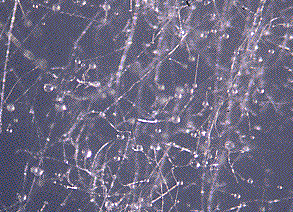







Like plants and animals, fungi are eukaryotic multicellular organisms. Unlike these other groups, however, fungi are composed of filaments called hyphae; their cells are long and thread-like and connected end-to-end, as you can see in the picture below. Because of this diffuse association of their cells, the body of the organism is given the special name mycelium, a term which is applied to the whole body of any fungus. When reproductive hyphae are produced, they form a large organized structure called a sporocarp, or mushroom. This is produced solely for the release of spores, and is not the living, growing portion of the fungus.

In addition to being filamentous, fungal cells often have multiple nuclei. In the chytrids and zygomycetes, the cells are coenocytic, with no distinction between individual cells. Rather, the filaments are long and tubular, with a cytoplasm lining and large vacuole in the center. By contrast, the ascomycetes and basidiomycetes are septate; their filaments are partitioned by cellular cross-walls called septa. The structure of these septa varies, and is taxonomically useful.
Another feature of fungi is the presence of chitin in their cell walls. This is a long carbohydrate polymer that also occurs in the exoskeletons of insects, spiders, and other arthropods. The chitin adds rigidity and structural support to the thin cells of the fungus, and makes fresh mushrooms crisp.
Most members of the kingdom Fungi lack flagella; the structures are completely absent in all stages of their life cycle. The only exception are the chytrids, which produce flagellated gametes. The absence of flagella then, is a synapomorphy which unites all the remaining groups of fungi. This has had a tremendous impact on fungal biology, because it means that no fungus can produce motile gametes, and two organisms must therefore come into direct physical contact to effect sexual reproduction. For more on reproduction in fungi, click on "Life History and Ecology".


